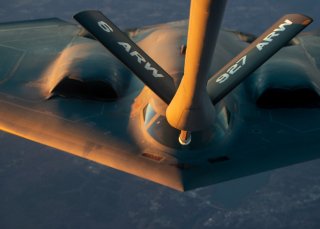America Should Fear China’s H-20 and H-6 Bomber Duo
While waiting for large numbers of its emerging H-20 stealth bomber to arrive, China has been consistently upgrading its legacy H-6 bomber to a degree that continues to generate U.S. concern.
While waiting for large numbers of its emerging H-20 stealth bomber to arrive, China has been consistently upgrading its legacy H-6 bomber to a degree that continues to generate U.S. concern.
The Xian H-6, which can be traced as far back as the Cold War era Tu-16, is mentioned thirty-three times in the Pentagon’s 2020 China Military Power report, according to an analysis by Flightglobal.
The report says the H-6 will likely fly into the 2030s, by virtue of an ongoing series of significant upgrades. Newer K, J and N variants of the aircraft are powered by two more efficient Soloviev D-30 turbofan engines.
“With much larger engine inlets to accommodate the upgraded powerplant, the K, J and N variants dispense with the original glass nose of the Tu-16 and H-6, replacing it with a solid nose housing for a passive electronically scanned array or, potentially, an active electronically scanned array radar. It also has an electro-optical/infrared turret under the fuselage. The tail gunner’s station found on previous iterations makes way for a fully enclosed tail,” the Flightglobal report says.
Yet another variant is believed to be an electronic warfare aircraft.
Adding to U.S. concerns is China’s new H-20 bomber, which is expected to fly alongside and ultimately replace the H-6. However, such a duo may be a ways away. The H-6’s life extension can be explained by the significant time that it may take to produce and deploy the H-20 in sufficient numbers.
This kind of phased pattern does, to some extent, resemble the U.S. plans with the B-2 and B-21 stealth bombers. The thirty-year-old B-2 is expected to fly for many more years until sufficient numbers of the B-21 arrive. Therefore, in a manner not totally unlike China’s plans for the H-6, the B-2 continues to be upgraded with new weapons, sensors, and computer technology to propel the aircraft into the future service.
However, while the H-20 still remains mysterious to a large degree, it may not come close to rivaling the Air Force’s new B-21, which will deliver unprecedented capabilities.
Quoting “military sources,” a report from The New Zealand Herald said the new and still somewhat mysterious H-20 bomber could make its first public appearance at this year’s Zhuhai Airshow in November—depending upon how things progress with the coronavirus pandemic.
According to the report, the H-20 supersonic stealth bomber could “double” China’s strike range, putting the U.S. homeland at risk. Indeed, the H-20 was cited in the Pentagon’s 2018 and 2019 annual “China Military Power Report.” The 2019 report specifies that the new H-20 will likely have a range of “at least 8,500km” and “employ both conventional and nuclear weaponry.”
Kris Osborn is the defense editor for the National Interest. Osborn previously served at the Pentagon as a Highly Qualified Expert with the Office of the Assistant Secretary of the Army—Acquisition, Logistics & Technology. Osborn has also worked as an anchor and on-air military specialist at national TV networks. He has appeared as a guest military expert on Fox News, MSNBC, The Military Channel, and The History Channel. He also has a Master’s Degree in Comparative Literature from Columbia University.
Image: DVIDS.

